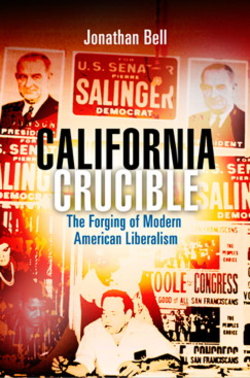California Crucible

Реклама. ООО «ЛитРес», ИНН: 7719571260.
Оглавление
Jonathan Bell. California Crucible
Отрывок из книги
POLITICS AND CULTURE
IN MODERN AMERICA
.....
The labor movement, in particular, was in the late 1940s reeling from the twin pressures of bitter internal divisions over the legacy of the popular front and its peculiar relationship with the two main political parties in California. The November 1947 meeting of the state CIO demonstrated the damaging schism appearing within organized labor over the putative third party challenge to President Truman over the question of communism and the nation's relationship with the Soviet Union. Some unions, led by CIO state secretary Bjorne Halling of the ILWU, remained popular front advocates, and in many cases were overtly communist-led. Others rallied to the resolution of the United Steel Workers, led by anticommunist John Despol, that stated that the “so-called Independent Progressive Party is neither independent nor progressive. Instead, it is more accurately described as a ‘Trojan Horse' party under the control of the fellow-travelers of the reactionary American agents who, consciously or unconsciously, work for the establishment of a world police state which would deny the individual dignity of man.” Though the open challenge to Halling's leadership was defeated at the Santa Cruz meeting, the San Francisco News noted that a “growing influence of a rightist faction was apparent at the four-day session.”48 By mid-1948, CIO national chair Philip Murray had initiated a purge of communist-dominated unions from the organization, symbolized in California by Murray's removal of Harry Bridges of the International Longshore and Warehouse Union (ILWU) as northern director of the California CIO.49
The difficult political position of labor in California was underscored by an examination of the role of the much larger California Federation of Labor (CFL) in the postwar years.50 In the crucial election year of 1950, in which James Roosevelt was running for governor on an unashamedly left-of-center platform and Helen Douglas was struggling to help maintain the liberal forces' tenuous hold on the U.S. Senate, a key battleground in the fight to do something about Taft-Hartley, the Federation's League for Political Education held its first formal preprimary endorsing convention. As political parties were forbidden from endorsing primary candidates, and since the Democrats had not yet managed to establish their own equivalent to the Republican Assembly, the role of organized labor in giving guidance to its membership on whom to support could be significant in determining the future direction of state politics. This fact was not lost on the national director of the AFL'S political action wing, Joe Keenan, who told the assembled convention in San Francisco in April that the “year of 1950 is all-important for American labor. The labor movements of the whole world are watching us, and we are going into the bitterest campaign in the history of this country.” Keenan fiercely attacked Richard Nixon for distorting a debate about the future of the New Deal into one about communism, noting the devastating impact anticommunism had already had on primary elections in Florida and North Carolina, as well as on labor's chances of toppling the author of the notorious Taft-Hartley Act, Senator Robert Taft of Ohio. “We in Washington,” he told the California delegates, “hope to get enough information to you so that you can acquaint the people with the laws that the American Federation of Labor is concerned with…laws such as social security, minimum wage, aid to education, housing, and, most of all, health insurance.”51 The battles for Fair Deal measures such as federal health insurance and against Taft-Hartley had further welded together the political fortunes of labor and the Democratic Party, and in some respects the San Francisco meeting of the AFL'S California membership reflected this development: Helen Douglas and James Roosevelt both gained labor's blessing, and both addressed the assembled throng. “My fight has been your fight,” proclaimed Douglas in an impassioned speech, “and I will continue to work for the economic bill of rights that President Roosevelt outlined for us: a decent home for every family; a job at a decent wage; the repeal of the Taft-Hartley Act [loud applause]; the extension of the social security program; the extension of our educational opportunities for young people; the realization of our civil liberties for all the people.”52
.....